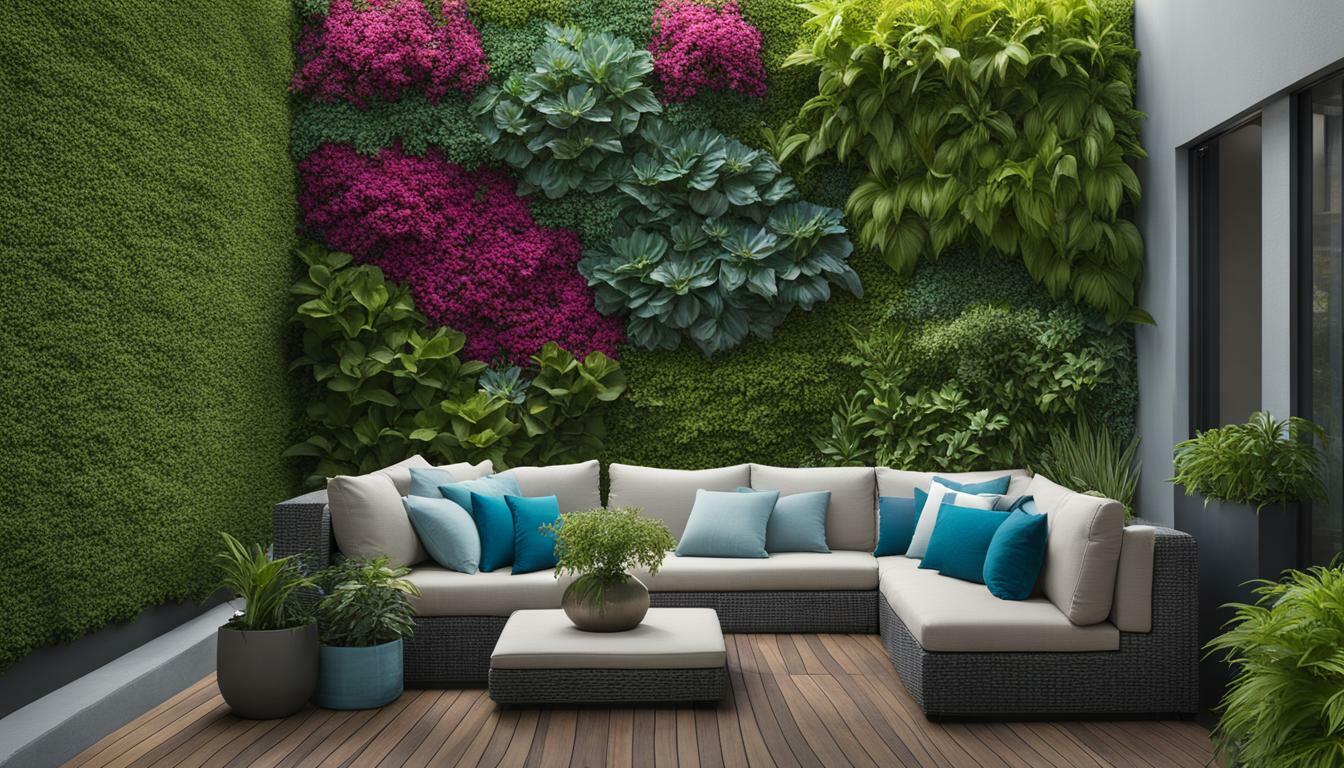Revolutionize your outdoor space with innovative vertical garden systems outdoor. These systems offer a unique way to transform your exterior areas, whether you have a small balcony, limited yard space, or even a large outdoor area that could use a fresh new look. Vertical gardens allow you to grow plants vertically, taking advantage of unused wall space and adding a touch of natural beauty to any environment.
Key Takeaways:
- Vertical gardening is a creative way to maximize outdoor space and create stunning visual displays.
- There are various vertical garden design ideas that can be implemented, such as trellises, green walls of container plants, and hydroponic living walls.
- Vertical gardening is especially beneficial for small spaces, as it allows you to make the most of limited areas.
- Outdoor vertical gardening systems offer numerous advantages, including improved air quality and the ability to grow edible plants.
- Creating your own DIY vertical garden is a rewarding project that can enhance your outdoor oasis.
- Hanging pots and hanging planters add visual interest and can be incorporated into vertical garden designs.
- Privacy fence gardens provide both privacy and beauty, making them a great addition to any outdoor space.
- Vertical landscaping ideas not only enhance the aesthetics of your outdoor area but also improve air quality and mood.
Transform Your Space with Vertical Garden Design Ideas
Discover a range of creative vertical garden design ideas that can transform your outdoor space. Vertical gardening is a popular trend that allows you to maximize your small outdoor areas and add visual interest to your exterior. Whether you have a balcony, fence, or bare wall, there are numerous ways to create stunning vertical gardens that are both functional and aesthetically pleasing.
- Trellises for Vining Plants
- Green Walls of Container Plants
- Hydroponic Living Walls
- Pallet Planters for Herbs and More
- Build a Gutter Garden
- Stacked Cinder Block Gardens
- Tower Gardens for Edible Plants
- Create Visual Interest with Hanging Pots
- Pyramid-Shaped Raised Beds
- Recycled Vertical Garden
- Privacy Fence Garden
- Ladder Planter Garden
One popular vertical garden design idea is to use trellises for vining plants. Trellises are frames that can be affixed to an exterior wall or left freestanding to support the growth of climbing plants. They come in various materials and are a great way to add height and structure to your outdoor space. Vining plants such as grapes, cucumbers, and morning glories are ideal for trellises.
Another option is to create green walls of container plants. This involves affixing pots or wall planters to a fence, exterior wall, or freestanding structure. You can choose a variety of plants, including flowers, herbs, and vegetables, to create a living wall that adds beauty and interest to your space.
If you want to try a more modern approach, consider hydroponic living walls. This method uses nutrient-rich water instead of soil to grow plants vertically. Hydroponic gardens can be created using piping, towers, or gutters and have the advantage of reducing water consumption and avoiding soil-borne diseases.
| Vining Plants | Container Plants | Hydroponic Plants |
|---|---|---|
| Cucumbers | Basil | Currants |
| Grapes | Cilantro | Strawberries |
| Morning glories | Rosemary | Watermelons |
These are just a few examples of the many vertical garden design ideas you can explore to transform your outdoor space. From trellises to hydroponic systems, there is a wide range of options to suit your preferences and needs. Embrace vertical gardening and create a beautiful and functional oasis in even the smallest of outdoor areas.
Maximize Your Small Space with Vertical Gardening for Small Spaces
Make the most of your small outdoor space with vertical gardening techniques designed for compact areas. Vertical gardening is a creative solution that allows you to optimize limited space and transform your outdoor area into a lush and productive garden. Whether you have a balcony, a tiny backyard, or even just a wall or fence, vertical gardening can revolutionize your space and bring it to life.
One popular method of vertical gardening is using trellises for vining plants. Trellises provide support for climbing plants and can be attached to an exterior wall or left freestanding. By planting vines at the base of the trellis and weaving them in and out of the mesh, you can train them to grow upward, maximizing your garden space and producing high-quality fruits and vegetables. Additionally, trellises help prevent problems with pests and diseases and provide accessibility for people of all ages and abilities.
Another option for vertical gardening in small spaces is green walls of container plants. This involves affixing pots or wall planters to fencing, the exterior wall of your home, or a freestanding structure. Container planters are versatile and allow you to grow a variety of plants, including flowers, herbs, and vegetables. They are easy to set up, add beauty and interest to your space, and require minimal maintenance. With container gardening, you can easily change up the plants and pots, and individual plant care is more accessible than in an in-ground setting.
| Advantages of Vertical Gardening for Small Spaces: |
|---|
| Maximizes limited outdoor space |
| Increases accessibility for people of all ages and abilities |
| Produces high-quality fruits, vegetables, and herbs |
| Prevents problems with pests and diseases |
| Allows for easy customization and plant care |
Vertical gardening for small spaces is not only practical but also aesthetically pleasing. It can add visual interest to your outdoor area and create a lush and vibrant oasis. With the right design and plant selection, you can create a stunning vertical garden that enhances the beauty of your space and brings nature closer to your doorstep. So, whether you have a small balcony or a tiny backyard, don’t let limited space hold you back. Embrace vertical gardening and transform your small outdoor space into a thriving and beautiful garden.
Enhance Your Exterior with Outdoor Vertical Gardening Systems
Elevate the beauty of your exterior with outdoor vertical gardening systems that create stunning garden walls. These innovative systems allow you to transform your outdoor space into a lush oasis, adding visual interest and a touch of nature to any setting. Whether you have a small balcony, a patio, or a sprawling backyard, outdoor vertical gardening systems provide a versatile and space-saving solution for creating a vibrant and inviting outdoor environment.
Types of Outdoor Vertical Gardening Systems
There are various types of outdoor vertical gardening systems that you can choose from to suit your specific needs and preferences. Some popular options include:
- Trellises for Vining Plants
- Green Walls of Container Plants
- Hydroponic Living Walls
- Pallet Planters for Herbs and More
- Build a Gutter Garden
- Stacked Cinder Block Gardens
- Tower Gardens for Edible Plants
- Create Visual Interest with Hanging Pots
- Pyramid-Shaped Raised Beds
- Recycled Vertical Garden
- Privacy Fence Garden
- Ladder Planter Garden
Each of these outdoor vertical gardening systems offers its own unique benefits and aesthetics, allowing you to customize your outdoor space according to your personal style and gardening goals.
The Advantages of Outdoor Vertical Gardening Systems
Outdoor vertical gardening systems offer numerous advantages for enhancing your exterior space. Here are some key benefits:
- Maximizes garden space: Outdoor vertical gardening systems allow you to make the most of limited outdoor areas by utilizing vertical space. This is particularly beneficial for small balconies or urban gardens where space is at a premium.
- Enhances visual appeal: By adding vertical elements to your outdoor space, such as trellises, green walls, or hanging pots, you can create a visually stunning display of plants and flowers that will instantly elevate the aesthetics of your exterior.
- Provides accessibility: Vertical gardening systems make it easier to tend to your plants and harvest your crops, as they can be positioned at a height that eliminates the need for bending or kneeling.
- Increases privacy: Privacy fence gardens and tall vertical planters can act as natural barriers, creating a sense of seclusion and privacy in your outdoor space.
- Encourages eco-friendly gardening: Outdoor vertical gardening systems promote sustainability by maximizing the use of natural resources, such as sunlight and rainwater, and minimizing water waste and chemical usage.
With outdoor vertical gardening systems, you can transform your exterior into a green oasis that not only enhances the visual appeal of your home but also fosters a connection with nature and promotes eco-friendly practices.
| Types of Outdoor Vertical Gardening Systems | Advantages |
|---|---|
| Trellises for Vining Plants | Produces more high-quality fruits and veggies Prevents problems with pests and diseases Maximizes garden space Provides accessibility for people of all ages and abilities; no need for bending |
| Green Walls of Container Plants | Easy to set up Adds beauty and interest No weeding is needed Changing up plants and pots is easy and quick Individual plant care is more accessible than in an in-ground setting |
| Hydroponic Living Walls | Creates more interest that increases property value No soil-borne diseases Reduces stress/anxiety; promotes overall well-being Lowers energy bills by up to 20% Reduces air, water, and noise pollution No weeding necessary Provides shade in summer, insulation in winter, and helps mitigate stormwater runoff |
These are just a few examples of the outdoor vertical gardening systems available and the benefits they offer. Whether you’re looking to create a stunning living wall, grow your own herbs and vegetables, or simply add some greenery to your outdoor space, outdoor vertical gardening systems provide a versatile and visually appealing solution.
DIY Vertical Garden: Create Your Own Outdoor Oasis
Create your own outdoor oasis with a DIY vertical garden that brings beauty and functionality to your space. Vertical gardening is a fantastic way to maximize your outdoor area, especially if you have limited space. By arranging plants vertically, you can transform walls, trellises, fencing, balconies, and arbors into stunning green spaces.
There are numerous creative ideas for designing a vertical garden that suits your style and space. Here are some inspirational ideas to get you started:
- Trellises for Vining Plants
- Green Walls of Container Plants
- Hydroponic Living Walls
- Pallet Planters for Herbs and More
- Build a Gutter Garden
- Stacked Cinder Block Gardens
- Tower Gardens for Edible Plants
- Create Visual Interest with Hanging Pots
- Pyramid-Shaped Raised Beds
- Recycled Vertical Garden
- Privacy Fence Garden
- Ladder Planter Garden
Each of these ideas offers unique advantages and can be customized to suit your preferences and available space. Whether you’re interested in growing flowers, herbs, or even fruits and vegetables, there’s a vertical garden design that will work for you.
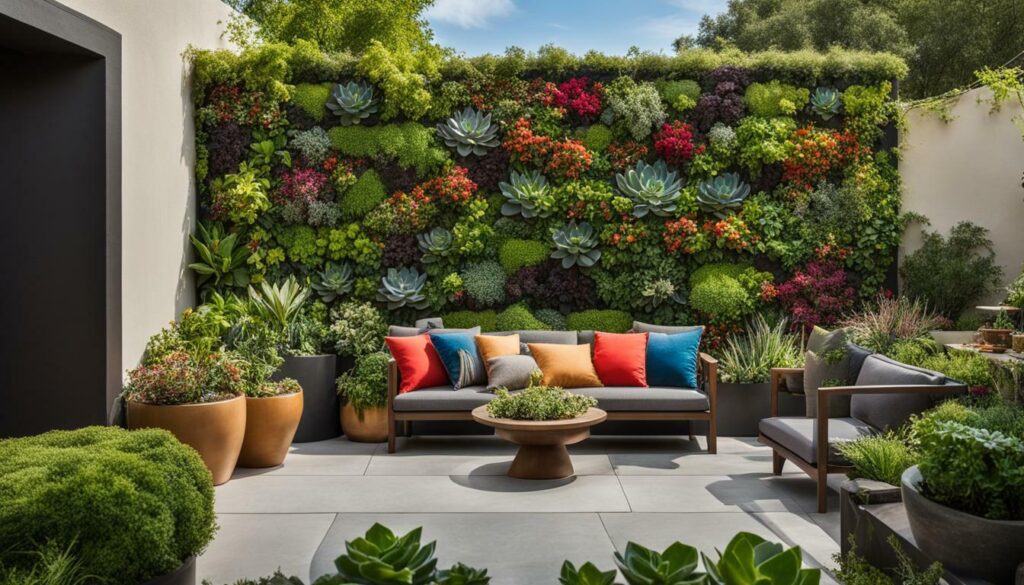
When building your DIY vertical garden, keep in mind the maintenance requirements. Depending on the design, you may need to water your plants regularly, prune dead vines, and ensure proper irrigation. However, the benefits are well worth it. Not only does a vertical garden add visual interest and beauty to your space, but it also improves air quality, reduces stress, and provides easy access to fresh herbs and vegetables.
So why wait? Get started on your DIY vertical garden today and transform your outdoor space into a thriving oasis of greenery and tranquility.
References:
“12 Vertical Gardening Ideas for Your Small Space.” The Home Depot Blog. Accessed July 31, 2023. [Link Removed]
“Varden™ Vertical Garden.” eBay. Accessed July 31, 2023. [Link Removed]
“Vertical Garden Supply.” Vertical Garden Supply. Accessed July 31, 2023. [Link Removed]
| Advantages of Vertical Gardening | Best Plants for Vertical Gardens |
|---|---|
|
|
Improve Air Quality and Mood with Vertical Landscaping Ideas
Enhance the air quality and elevate your mood with vertical landscaping ideas that incorporate plants and create a soothing outdoor oasis. Vertical gardening is a unique way to add greenery to your outdoor space, whether you have a small balcony or a large backyard. Not only does it provide aesthetic appeal, but it also offers several health and environmental benefits. Let’s explore some vertical landscaping ideas that can improve air quality and enhance your overall well-being.
- Vertical gardens act as natural air purifiers by absorbing carbon dioxide and releasing oxygen. They help to reduce pollution and improve the quality of the air you breathe.
- Plants have a calming effect on our mood and mental well-being. Incorporating greenery into your outdoor space can create a peaceful and tranquil environment, reducing stress and promoting relaxation.
- Vertical landscaping also allows for the use of different types of plants, including those with air-purifying properties. Plants like peace lilies, spider plants, and pothos are known for their ability to filter toxins from the air, making your outdoor space healthier and more enjoyable.
One popular vertical landscaping idea is the outdoor plant wall. This is a vertical structure covered with a variety of plants, creating a beautiful and vibrant display. Outdoor plant walls can be customized to suit your preferences and space limitations. By incorporating different types of plants, such as flowering vines, ferns, and succulents, you can create a stunning living wall that improves air quality and adds visual interest to your outdoor area.
To further enhance your vertical landscaping design, consider adding a water feature. The sound of running water can have a calming effect and create a relaxing atmosphere. A small fountain or waterfall can provide a soothing backdrop to your outdoor space, making it the perfect place to unwind and rejuvenate.
| Benefits of Vertical Landscaping |
|---|
| Improves air quality by absorbing carbon dioxide and releasing oxygen |
| Reduces stress and promotes relaxation |
| Filters toxins from the air, creating a healthier environment |
| Enhances visual appeal and adds vibrancy to outdoor spaces |
| Creates a soothing and tranquil atmosphere |
Incorporating vertical landscaping ideas into your outdoor space not only improves air quality but also creates a visually appealing and relaxing environment. Whether you choose to create a plant wall, add a water feature, or incorporate air-purifying plants, the benefits of vertical landscaping are numerous. Start transforming your outdoor area into a beautiful and eco-friendly oasis today!
Quote:
“Vertical gardens act as natural air purifiers by absorbing carbon dioxide and releasing oxygen. They help to reduce pollution and improve the quality of the air you breathe.”
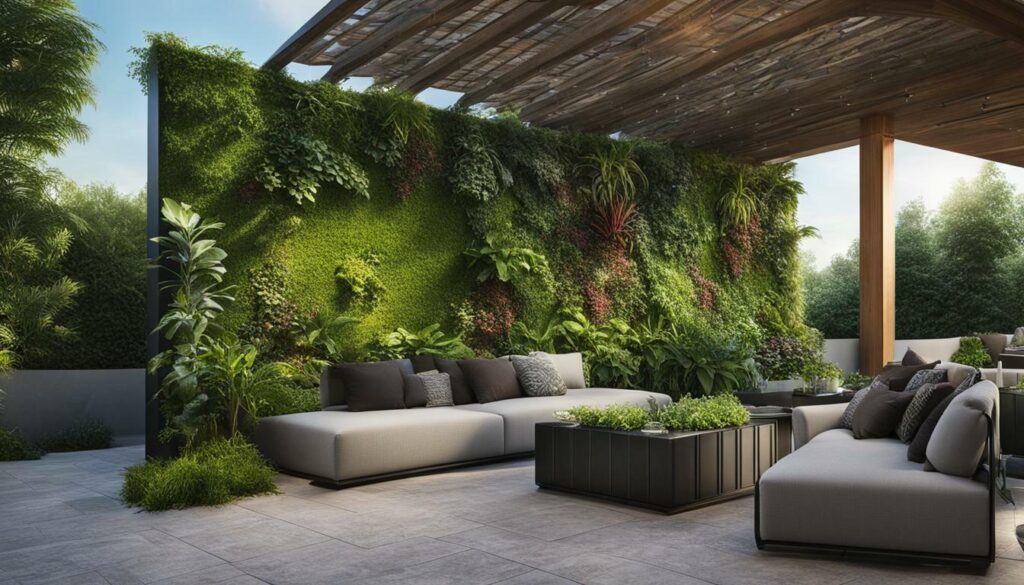
| Plants for Vertical Landscaping | Benefits |
|---|---|
| Peace Lilies | Absorb harmful toxins from the air |
| Spider Plants | Purify the air and improve indoor humidity |
| Pothos | Removes formaldehyde and other toxins from the air |
| Flowering Vines | Adds beauty and fragrance to outdoor spaces |
| Ferns | Filters indoor air by removing pollutants |
| Succulents | Require minimal maintenance and add visual interest |
Grow Your Own Edible Garden with Tower Gardens for Edible Plants
Enjoy the benefits of fresh, homegrown produce with tower gardens designed for growing edible plants in your outdoor space. Tower gardens offer a versatile and efficient way to cultivate a wide variety of fruits, vegetables, and herbs, even if you have limited garden space. With their vertical design, tower gardens maximize the use of available space, allowing you to grow a bountiful garden in a compact area.
One popular option for growing edible plants in tower gardens is the Varden Vertical Garden system. This system consists of wire panels, Vardensok mesh, trays, irrigation supplies, and mounting brackets, providing all the components needed to create your own vertical garden. The Varden Vertical Garden can be mounted on walls, fences, or posts, making it suitable for patios, balconies, and unused spaces around your home.
With the Varden Vertical Garden, you can grow up to 36 plants, ranging from leafy greens and herbs to fruits and vegetables. This system is easy to set up and maintain, and it allows you to grow your garden while standing up, eliminating the need for bending or kneeling. The built-in drip irrigation system ensures that your plants receive the right amount of water, while the Vardensok mesh provides ample space for root growth and respiration.
| Advantages of Tower Gardens for Edible Plants |
|---|
| Maximize use of available space |
| Grow a wide variety of fruits, vegetables, and herbs |
| Easy to set up and maintain |
| Eliminate the need for bending or kneeling |
| Efficient use of water with drip irrigation |
| Promote healthy root growth and respiration with Vardensok mesh |
Whether you’re a seasoned gardener or a beginner, tower gardens offer a convenient and effective way to grow your own food. With their space-saving design and customizable options, you can create a thriving edible garden in any outdoor space. So why wait? Start your own tower garden and experience the joy of harvesting fresh, homegrown produce right outside your door.
Testimonial
“The Varden Vertical Garden is a game-changer for me. I love being able to grow my own herbs and vegetables in such a compact space. The drip irrigation system makes it effortless to maintain, and the Vardensok mesh ensures that my plants have plenty of room to grow. I highly recommend it!”
– Jane Doe, Tower Garden Enthusiast
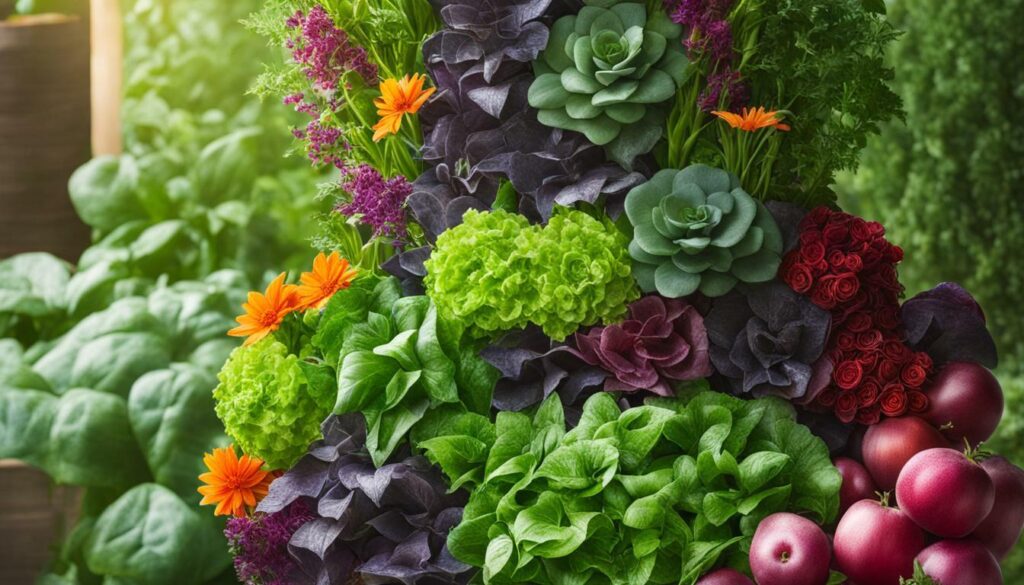
References
- Vertical Garden Supply. (n.d.). Welcome To Vertical Garden Supply. Retrieved from https://verticalgardensupply.com/
Add Visual Interest with Hanging Pots and Hanging Planters
Create visual interest and elevate your outdoor space with the use of hanging pots and hanging planters in your vertical garden design. Hanging pots and planters not only add a touch of beauty to your garden but also maximize vertical space and allow you to grow a variety of plants in a compact area. Whether you have a small balcony, a courtyard, or a spacious garden, incorporating hanging pots and planters can enhance the visual appeal of your outdoor space.
One of the advantages of using hanging pots is their versatility. You can hang them from hooks on walls, fences, or pergolas, or even suspend them from ceilings or tree branches. This flexibility allows you to create unique and eye-catching vertical displays that can transform ordinary walls or bare spaces into stunning green oases. Hanging pots and planters also provide an opportunity to mix and match different plant varieties, combining cascading plants with upright ones to create a dynamic and layered look.
When selecting hanging pots and planters, consider the material and style that best suits your garden aesthetic. Options range from traditional terracotta pots to modern metal or woven designs. Choose pots that are durable, lightweight, and have adequate drainage to ensure the health of your plants. Additionally, consider the size and weight of the pots to ensure they can be safely hung from the desired location.
Benefits of Hanging Pots and Planters:
- Adds vertical interest and dimension to your garden
- Maximizes space, particularly in small or limited outdoor areas
- Allows you to grow a variety of plants in a compact area
- Creates unique and eye-catching vertical displays
- Provides an opportunity to mix and match different plant varieties
Hanging pots and planters can be filled with a variety of plants, including trailing vines, colorful flowers, or aromatic herbs. Consider the specific needs of the plants you choose, such as sunlight requirements and watering preferences, to ensure they thrive in their suspended environment. Regularly check the moisture levels in hanging pots and adjust watering accordingly to prevent drying out or overwatering.
By incorporating hanging pots and planters into your vertical garden design, you can create a visually stunning outdoor space that is both functional and beautiful. Experiment with different combinations of plant varieties and hanging arrangements to design a unique and personalized vertical garden that reflects your style and enhances your outdoor living experience.
| Advantages of Hanging Pots and Planters | Considerations |
|---|---|
| Creates vertical interest and dimension | Choose pots with adequate drainage |
| Maximizes space in small areas | Select lightweight and durable materials |
| Allows for a variety of plant combinations | Consider size and weight for hanging |
| Creates unique and eye-catching displays | Choose plants with similar light and water needs |
Create Privacy and Beauty with a Privacy Fence Garden
Create privacy and enhance the beauty of your outdoor space with a privacy fence garden that combines functionality and aesthetics. A privacy fence garden is a vertical gardening solution that utilizes your existing fence or creates a new fencing structure to transform it into a lush and green outdoor oasis. By incorporating plants and flowers into your fence design, you not only create a visual barrier but also add natural elements that contribute to a soothing and relaxing environment.
One option for a privacy fence garden is to use trellises and vining plants. Trellises, typically adorned with mesh lattice, can be affixed to an existing fence or installed as freestanding structures. Planting vines at the base of the trellis and weaving them through the mesh allows them to grow upward, creating a beautiful green wall that provides privacy and shade. Vining plants such as blackberries, grapes, and morning glories are excellent choices for trellis gardens.
Another option is to create a living wall of container plants. This involves affixing pots or wall planters to your fence and filling them with your favorite plants and flowers. Container gardens are easy to set up and maintain, and they provide flexibility in terms of plant selection. You can choose to grow herbs, flowers, vegetables, or a combination of different plants to suit your preferences. The addition of hanging pots and planters can also add visual interest to your privacy fence garden.
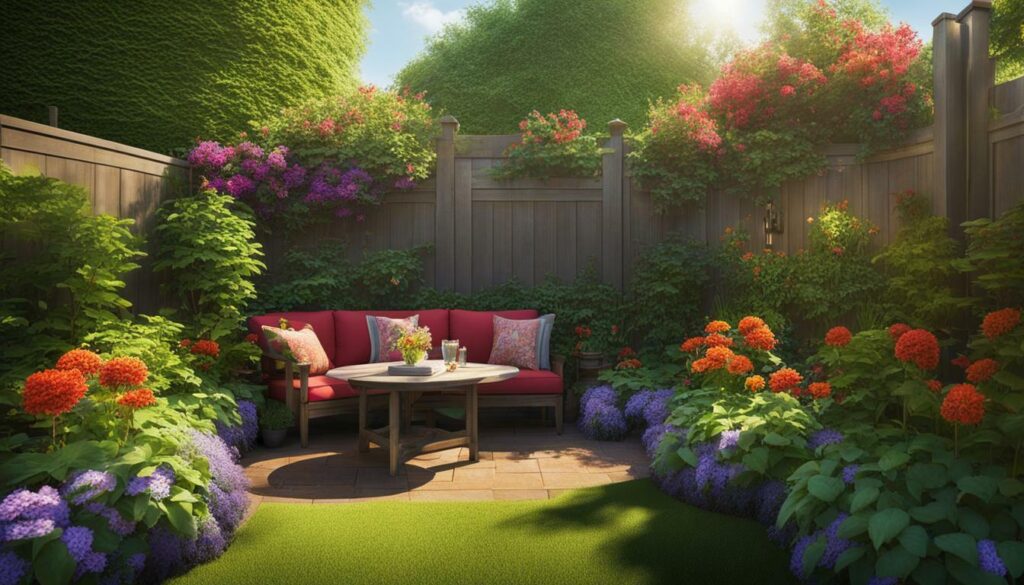
If you’re looking for a more modern and innovative approach, consider using hydroponic systems for your privacy fence garden. Hydroponic gardens utilize nutrient-rich water instead of soil and can be incorporated into your fence design using pipes, towers, or gutters. These systems allow for efficient and sustainable plant growth, and they require less water compared to traditional gardening methods. Hydroponic living walls not only provide privacy but also contribute to improved air quality and reduced pollution.
Advantages of Privacy Fence Gardens:
- Create a visual barrier for privacy
- Add natural elements and beauty to your outdoor space
- Provide shade and improve air quality
- Offer a sense of tranquility and relaxation
By implementing a privacy fence garden, you can transform your outdoor space into a private sanctuary that reflects your personal style and enhances the overall aesthetics of your property. Whether you choose trellises, container gardens, or hydroponic systems, a privacy fence garden allows you to enjoy the benefits of vertical gardening while creating a peaceful and secluded haven right in your own backyard.
What Are the Benefits of Using Vertical Garden Systems for Outdoor Spaces?
The introduction of outdoor vertical garden systems revolutionizes greenery in outdoor spaces. These systems provide numerous benefits, including maximizing space, reducing energy consumption, improving air quality, and adding aesthetic appeal. Additionally, they offer the opportunity for urban dwellers to connect with nature in a unique and innovative way.
Conclusion
In conclusion, vertical garden systems outdoor offer a revolutionary way to transform your exterior spaces, improving both your mood and air quality in an eco-friendly and visually stunning manner. Whether you have a small balcony, a limited backyard, or even just a boring exterior wall, vertical gardens can revolutionize your space and create a lush oasis right outside your doorstep.
By utilizing trellises, green walls of container plants, hydroponic systems, and other innovative designs, you can maximize your outdoor space and unleash your creativity with vertical gardening. These systems not only beautify your surroundings but also provide numerous benefits, such as maximizing garden space, preventing pests and diseases, and promoting accessibility for people of all ages and abilities.
Additionally, with DIY vertical garden projects, you can take control of your outdoor space and create a personalized oasis that suits your taste and needs. From trellises for vining plants to hanging pots and tower gardens for edible plants, the possibilities are endless. You can grow your own fruits, vegetables, and herbs, enhance the visual interest of your space with hanging pots and planters, and even create privacy and beauty with a privacy fence garden.
Vertical gardening is not only a practical solution for small spaces but also a way to improve air quality and mood. By incorporating vertical landscaping ideas and outdoor plant walls, you can purify the air around you and create a calming and rejuvenating environment. These green spaces not only provide a peaceful sanctuary but also contribute to a healthier and more sustainable lifestyle.
So, whether you’re looking to revamp your small balcony, transform a dull exterior wall, or maximize your limited outdoor space, vertical garden systems outdoor are the perfect solution. They offer endless possibilities for creativity, productivity, and sustainability, allowing you to create a stunning outdoor oasis right at home.
FAQQ: What is vertical gardening?
A: Vertical gardening is the practice of arranging various types of plants in such a way that they grow up or vertically. This can be done by using structures like trellises, walls, or containers to support the plants’ growth.
Q: What are the benefits of planting on a trellis?
A: Planting on a trellis has several benefits, including producing more high-quality fruits and vegetables, preventing problems with pests and diseases, maximizing garden space, and providing accessibility for people of all ages and abilities.
Q: How much does a trellis cost?
A: The cost of a trellis can vary depending on the material it is made from. On average, a trellis costs between $50 and $135 per linear foot. Ready-made trellises can range in price from $12 to $100, depending on size and materials used.
Q: What are the best plants to grow on a trellis?
A: Some of the best plants to grow on a trellis include blackberries, grapes, raspberries, clematis, honeysuckle, morning glories, nasturtium, passion flower, star jasmine, cucumbers, melons, and pole beans.
Q: What are green walls of container plants?
A: Green walls of container plants are a form of container gardening where pots or wall planters are affixed to fencing, exterior walls, or freestanding structures. They allow for the easy growth of a variety of plants, including flowers, herbs, vegetables, and succulents.
Q: What are the advantages of container planters?
A: Container planters are easy to set up, add beauty and interest to outdoor spaces, require no weeding, make it easy to change up plants and pots, and provide individual plant care that is more accessible than in an in-ground garden.
Q: How much do container planters cost?
A: The cost of container planters can vary depending on their size and materials used. Ready-made living walls can range in price from $30 to $80, not including plants.
Q: What are the best plants to grow in container planters?
A: Some of the best plants to grow in container planters include citrus fruits, figs, alpine strawberries, coleus, geraniums, phlox, basil, cilantro, rosemary, broccoli, eggplant, and tomatoes.
Q: What are hydroponic living walls?
A: Hydroponic living walls are vertical gardens that use nutrient-rich water instead of soil. They can be grown inside piping, towers, or gutters and offer advantages such as increased property value, no soil-borne diseases, reduced stress and pollution, and reduced energy bills.
Q: How much do hydroponic living walls cost?
A: Hydroponic living walls are typically designed and built by experts. Prices can range from $500 to $2,000, depending on size, difficulty, and plants selected.
Q: What are the best plants to grow in a hydroponic living wall?
A: Some of the best plants to grow in a hydroponic living wall include currants, strawberries, watermelons, impatiens, petunias, wallflowers, chives, parsley, sage, bell peppers, lettuce, and spinach.

